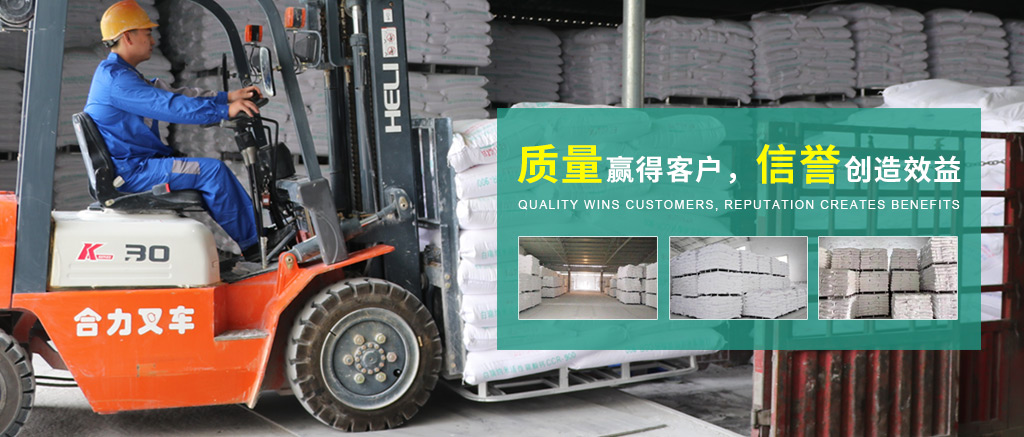Technical points of modified calcium carbonate for filling masterbatch (2)
Time: 2019-05-29
Preparation of active calcium carbonate
The particle size of active calcium carbonate has a great influence on its application, and 400 mesh to 500 mesh calcium carbonate is generally selected. The larger the particle size of calcium carbonate, the smaller the total specific surface area, the smaller the contact area with the resin, the worse the physical and mechanical properties of the product. However, the particle size of calcium carbonate is too small, it will produce condensation phenomenon, and it is difficult to disperse evenly in the resin. The calcium carbonate with a particle size of 400 mesh to 500 mesh was put into a high-speed mixer (kneading machine), and pre-dried at 110 ℃ to 120 ℃ for 5 ~ 10min, so that the moisture content of calcium carbonate was less than 0.5% (mass fraction, the same below), and then the aluminate coupling agent was added to the kneading machine, and continued to run for 5min. According to a lot of practice and theory, the amount of aluminate coupling agent added is 0.75 % ~ 2.5 % of calcium carbonate. When the temperature of the material in the standby drops below 80 ° C, the material can be discharged and packaged. Using the active calcium carbonate, the filler masterbatch is further prepared, and the masterbatch can be filled and used in the processing of plastic products. The filling amount can be determined according to the product type and use requirements, generally 5% ~ 30%. The use of such masterbatch can not only reduce the cost of the product, but also improve the physical and mechanical properties of the product.
4 Preparation of active calcium carbonate filled masterbatch
4. 1 Fill the basic components of the masterbatch
The basic particle unit of the masterbatch consists of four parts, namely, the filler core, the coupling layer, the dispersion layer and the mixing layer. Packing core (CaCO?) mainly plays a role in increasing capacity, increasing rigidity and reducing cost. The coupling layer is mainly composed of coupling agents and a small amount of crosslinking agents that have chemical and physical effects on the filler nucleus and the resin, which can improve the binding force between the filler and the resin. The dispersion layer is mainly composed of oligomers and dispersants, and its role is to make the treated powder (CaCO) better and more mixed with the mixers to form particles during the granulating process of the masterbatch. In addition, CACO ? plays a key role in improving the fluidity of the masterbatch and resin system, avoiding agglomeration of inorganic fillers, and improving the surface finish of the product. The mixing layer is mainly composed of a resin that has good compatibility with the resin to be filled and has certain mechanical properties and (or) a copolymer that has a certain double bond, because the amount of this layer is relatively large, it is directly in contact with the resin to be filled and is mixed, so it has a great impact on the mechanical properties of the system.
According to the above structural model, the formulation and preparation process of the filler masterbatch can be designed.
4. 2 Formula of filling masterbatch
From the above structural model, it can be seen that in addition to the filler core, there are carrier resins, coupling layers, dispersion layers and modifiers, etc., which should be considered in the formulation design. In the formulation design, the amount of filler core selected is 50% ~ 85% of the filler masterbatch. The choice of dispersion layer is mainly composed of low molecular weight polyethylene, or hard ester acid and its salts. Because of their low molecular weight and easy melting when mixed, calcium carbonate activated by coupling agent can be used, and then treated with dispersant to better melt and disperse in the resin, so that a better appearance quality of the filled product can be obtained. The calcium carbonate treated with the above dispersant is closer to the matrix resin in terms of solubility parameters, and the surface tension is similar to the matrix resin, so the viscosity of the composite decreases and the fluidity increases. The amount of dispersant generally does not exceed 3% of the filler masterbatch. The mixing layer is the carrier resin layer. The key technology of masterbatch is to make it evenly dispersed in plastic products, which is closely related to the choice of carrier resin. The general requirements for the selection of carrier resin are as follows:
(1) The carrier resin should be selected with the same or similar structure as the matrix resin to facilitate the compatibility of the masterbatch and the matrix resin;
(2) The carrier resin should have a high melt flow rate (MFR). The MFR of the melt should be slightly greater than that of the base resin.
(3) The carrier resin should preferably interact with a filler (CaCO?) or dispersant. The amount of carrier resin is generally 15% to 50% of the filler masterbatch.
4. 3 Preparation of filler masterbatch
(1) Composition of masterbatch
Filler core :500 mesh calcium carbonate 50
Coupling agent: aluminate DL-411 0.5
Dispersant: Stearic acid 2.5
Polyethylene wax 0.5
Carrier resin P5028S2 50
(2) Preparation process of masterbatch
Carrier resin PP5028S2, 50kg CaCO3, 2.5kg stearic acid and 0.5kg polyethylene wax treated with aluminate coupling agent in advance were put into the high-speed kneading machine in turn. After kneading for 5min, they were input into the extrusion material making device, and the masterbatch was obtained by melting and extruding granulation.
4. Application and benefit of masterbatch
Since the end of 1993, nearly 4000t of flat wire has been produced by filling polypropylene (PP5004) with homemade filling masterbatch. Compared with the general PP random material (app) as the carrier, homemade filling masterbatch has the following advantages: (1) large filling amount, that is, in the case of flat wire with the same physical property index, Its filling capacity can be increased by 2.5 ~ 3 times
The relationship between the tensile strength of silk and the filling amount of masterbatch
(1) The tensile strength of the flat wire reaches the highest value 0.35 ~ 0.36N/tex, at this time, the filling amount of the homemade masterbatch is 15%, and the filling amount of the purchased masterbatch is 5%. When the filling amount is low, the tensile strength of the flat yarn increases slightly with the increase of the filling amount. When the filling amount reaches a certain value, the tensile strength of the flat yarn decreases with the increase of the filling amount. This can be explained as follows: when the flat wire is subjected to external force, the coupling agent in the masterbatch has a coupling and entangling effect on PP macromolecules, which effectively transfers and transfers the stress, makes the stress disperse evenly, and delays the development process of the submicro crack of the PP flat wire. The result shows that the tensile strength of the flat wire increases with the increase of the masterbatch filling amount. When the filling amount of the masterbatch increases to a certain value, the intermolecular force (van der Waals force) of PP macromolecules is weakened more due to the increase of calcium carbonate content, which leads to the tensile strength of the flat wire decreases with the increase of the masterbatch.
(2) The flat wire production process is stable, the masterbatch is evenly dispersed, the raw material consumption is reduced, and the flat wire yield is improved.
(3) When simply using PP5004 flat wire weaving, there is always a small amount (about 35%) of flat wire cracking along the longitudinal, hair, heavy broken wire, affecting the weaving efficiency and quality; After adding the masterbatch, the cracking property of the flat yarn is obviously improved, and the weaving efficiency and product quality are improved.
Relationship between filament size and number of cracks
The cracking number of flat wire filled with masterbatch is 60% ~ 70% less than that of pure PP flat wire. With the increase of the fineness of the flat wire, the cracking number decreases. The mechanism of filling masterbatch to improve the cracking of flat wire can be explained as follows: When producing flat wire, during the drafting process, PP macromolecules are highly oriented along the direction of tensile force, and the horizontal connection of molecules is greatly weakened, so the flat wire is easy to crack during weaving; The flat wire containing masterbatch contains aluminate coupling agent, which has a coupling and binding effect on PP macromolecules, and can effectively transfer and transfer stress during weaving, so that the stress dispersion is more uniform, the horizontal strength of the flat wire is improved, and the cracking phenomenon of the flat wire is reduced.
(4) Significant economic benefits. The masterbatch has been applied in Liaohua Plastic Products Factory and considerable economic benefits have been obtained. The current flat wire production of the plant is 2100t/ a, and the masterbatch filling amount is 15%, that is, 315t of masterbatch can be used in a year. The production cost per ton of masterbatch is 5800 yuan, while the PP5004 is 10,300 yuan per ton. The raw material cost of 315 tons of masterbatch can be saved :315 ×(10300-5800) = 1.42 million yuan. When using the purchased app to fill the masterbatch, the filling amount is 5%, that is, 105t of masterbatch can be used in a year. The purchase price of masterbatch is 2400 yuan/t, and 105t masterbatch can save raw material cost :105 ×(10300-2400) = 830,000 yuan
It can be seen from the above that the use of homemade masterbatch can save the raw material cost of 590,000 yuan a year compared with the use of purchased masterbatch.
5 Conclusion
Through the preparation and application of masterbatch, the following conclusions can be drawn:
(1) From the technical and economic perspective, it is more appropriate to choose 400 ~ 500 mg CaCO? to prepare the filler masterbatch.
(2) The selection and use of coupling agent is very important, the selection of aluminate coupling agent can prepare a good compatibility with the matrix resin filler masterbatch.
(3) The vast majority of plastic products (except micro film and position extension film) can achieve the purpose of reducing the cost and improving the performance of the product by filling the masterbatch, but the amount of filling should depend on the type of product and the use of requirements, generally in thin products in the masterbatch filling amount should be less. When producing flat wire, the content of CaCO? should not exceed 7.5% (equivalent to the content of CaCO? in the raw material or flat wire when filled with 15% masterstock). Otherwise, it will reduce some of the physical properties of the flat wire, affect the use of the flat wire, and will also produce serious wear on the production of the flat wire and the equipment used.
(4) Due to the reasonable formulation and preparation process of the masterbatch, as well as the selection of the most effective coupling agent and the resin that is the same as the matrix resin and has better fluidity than the matrix resin as the carrier, the filling amount is more than 2 times higher than that of the app filled masterbatch.
(5) The use of the masterbatch can reduce the cracking of the flat wire and has significant economic benefits.







 Home
Home  News
News
